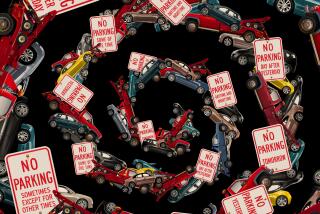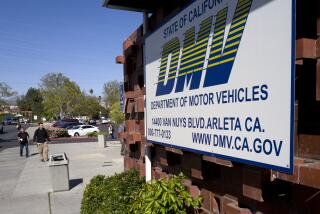Calling In Bad Teen Drivers
Some teenagers see a driver’s license as a permit to hit the open road with wild abandon, test the limits of the internal combustion engine and explore the road less traveled. All free of nagging parental restrictions.
Not so fast, junior.
From San Diego to Green Bay, Wis., concerned parents are trying to keep young drivers in check with a slew of new services that encourage other motorists to snitch on teens with dangerous driving habits.
The services are a variation on those 800 “How’s My Driving?” numbers used to keep tabs on millions of truck drivers nationwide.
At least a dozen toll-free teen tattle lines have popped up throughout California and the nation in the last few years--effectively putting Mom and Dad on speed dial. Subscribers to such services get a bumper sticker to put on their teen’s car, emblazoned with the phone number that other motorists can call.
The services represent just the latest example of the adult world grasping for tools to rein in teenagers--from the movie rating system to music warning labels to Internet blocking software.
But such systems have been fraught with trouble.
Porn-filtering software can be quickly disabled. Warning labels on CDs and tapes are easily ignored.
Even the much-touted V-chip, which allows parents to block inappropriate television shows, has not lived up to expectations. Only 17% of the homes with V-chip-equipped TV sets use them, according to a 2001 survey.
The struggles of the fledgling teen driver lines prove, once again, that technology has its limits and can help protect youngsters only when parents play an active role. Services such as 877-DADSEYES, 866-2TELLMOM and 800-4MYTEEN are still hard pressed to attract enough subscribers to make a profit.
Problems Blamed on Teens’ Resistance
The parents who founded most of these services blame a lack of advertising funds for their struggles. But the biggest hurdle remains the stubborn resistance of rebellious teens, ever-adept at sabotaging parental restraints.
At least one phone service went out of business because parents soon realized that teens were removing or covering the bumper stickers as soon as they pulled away from home.
Still, the founders of the phone-in services believe the time is ripe for a community of concerned motorists to begin watching over the nation’s young drivers. Or to torture the words of former First Lady Hillary Rodham Clinton: It takes a village to tame a teen driver.
The founders say the idea behind the phone numbers is not to get teens in trouble but to make them think twice before driving like maniacs.
“The biggest part of the program is the fear that the parents are going to find out,” said Jay Van Zeeland, a part-time paramedic who launched a teen driving line.
Most teens, of course, hate the idea that every move they make on the road could be reported to Mom and Dad.
“I think it’s horrible,” McKenzie Miller, 15, of Pasadena said as she waited at the Pasadena Department of Motor Vehicles office to take her driver’s license test.
Miller insisted that she will drive safely, even if a bumper sticker does not beg other motorists to snitch on her. Miller also worried that the bumper sticker would give other kids a reason to tease her.
Miller’s mom, Donna, said she would consider signing on for such a program, regardless of the ribbing her daughter might take. The mother of six kids--five of whom drive--said her worried mind would be put at ease knowing that other motorists were helping monitor her kids. “I think that teaching kids to drive is a community effort,” she said.
Randy Rekerdres, an insurance agent from Dallas, recently signed up for 866-2TELLMOM for his 16-year-old daughter, calling it “the best thing I’ve ever seen.”
As part of the service, Rekerdres received a bumper sticker emblazoned with the words “How’s My Driving?” It also included an Internet address, www.tell-my-mom.com, and the toll-free number where motorists can report on his daughter’s driving.
His daughter, Anne, doesn’t like the idea, saying it makes her look “nerdish.”
To ensure that his daughter doesn’t try to subvert his efforts, Rekerdres said he warned her that she will lose her driving privileges for a month if she tries to cover up or tear off the bumper sticker.
Rekerdres calls his daughter a “good kid” who earns top grades. “But when kids get out in these cars by themselves, they take on a whole new persona.”
Operators of the teen monitoring lines say the phoned-in reports run the gamut--from compliments for safe driving to complaints about teenagers smoking marijuana and flashing their bare bottoms out of speeding cars.
One recent report to 866-2TELLMOM went this way:
“The blond girl was driving and one of the males rolled down the passenger side window and threw out a Coke bottle. The bottle hit my hood and then my windshield, putting a chip in it. I had to speed up to 90 mph in order to get the vehicle’s license plate number.”
Speeding Car Led to a Line
Most of the toll-free numbers are operated by parents with good intentions but little money.
Van Zeeland got the idea for 866-2TELLMOM two years ago, shortly after a teenage driver sped through a red light and narrowly missed his car at an intersection outside Green Bay.
He caught up to the speeding teen, only to be told off “in language you couldn’t print.” Van Zeeland had just one thought: “Someone should tell her parents.”
Russell Howard, a police officer with two teenage daughters, started his teen number in Sunnyvale, Calif., after witnessing the deadly results of too many teen auto crashes.
Bill Durney, a computer programmer from San Diego, launched his toll-free number after a traffic accident near Poway killed two teenagers.
One of his customers was Lori Volano, the mother of two teenagers in Atlanta. She required her 17-year-old daughter to keep the bumper sticker on the car for the first six months after she got her license.
Volano is glad she did it.
“It’s a great way to have them really think what they are doing when they are driving,” she said.
One motorist reported that Volano’s daughter had been driving with a passenger who wasn’t wearing a seat belt. Volano took away her daughter’s driving privileges for a week.
Most services charge $19 to $55 a year to take the reports from the toll-free lines and relay them to parents. The smaller operations have a few dozen subscribers. The most popular have up to 2,000 subscribers.
In contrast, the four or five companies that operate the toll-free monitoring numbers for commercial vehicles combine to monitor more than 2 million commercial vehicles, according to industry officials.
Renee Kauffman, a mother from Oakhurst, Calif., launched 877-LETMEKNOW in 1998 just after her teen son began to drive. But her service attracted only 35 customers and quickly folded.
“Parents loved it, but teens refused to leave the stickers on the cars,” Kauffman said.
She started the service because teens in her community were driving around town “with a cowboy mentality,” Kauffman said. That has not changed since her service went bust. “Now I just pray a lot,” she said, “and hope for the best.”
There is good reason for parents to pray a lot.
Auto accidents are the leading cause of death for young people between the ages of 15 and 20. In 2000, 3,594 drivers in that age group were killed and an additional 348,000 were injured in car crashes nationwide, according to the National Highway Traffic Safety Administration.
State Targets Teen Drivers
Teens are more likely to be involved in crashes than any other age group because they have little driving experience but tend to take more risks behind the wheel than older drivers, experts say.
And teens are more often involved in fatal crashes when other passengers--usually other teens--are in the car, according to accident statistics.
For these and other reasons, 31 states, including California, have adopted graduated driver’s license programs that impose tough restrictions on new drivers under the age of 18.
In California, new drivers under 18 must hold their learner’s permit for at least six months before getting a provisional license. During that time, they must spend at least 50 hours behind the wheel practicing with a parent or guardian.
Also, for the first year, teenagers with provisional licenses cannot drive between midnight and 5 a.m. unless a licensed driver 25 years or older is riding along.
A recent study by the Auto Club of Southern California showed that the number of teenage auto deaths has dropped significantly since the driving restrictions took effect in California in 1998.
Safe driving advocates, such as Mothers Against Drunk Driving, applaud the efforts of the parents who operate the toll-free teen driving numbers. But experts say there are no studies to show the phone services save lives.
Truck companies that use the “How’s My Driving?” monitoring services get a break on insurance rates.
But teen drivers who are monitored by the new teen tattle lines do not get the same discount.
Auto insurance firms including 21st Century say they can’t offer teens the discounts until studies show the services work.
The founders of the teen phone lines hope that will change soon, giving parents an added monetary incentive to sign up.
But it may take more than a break on insurance to make the services succeed.
Just ask Llewellyn P. Haden Jr., president of FleetSafe, the Atlanta company that developed the first toll-free “How’s My Driving?” number to monitor trucks and commercial fleets.
Haden said his firm has twice tried to branch into the teen driver market.
But it failed both times, he said, due to heavy resistance from teens and an unwillingness from parents to lay down the law.
“It does not work, for the basic reason that teenagers are teenagers,” he said.
“They will put masking tape over the bumper sticker,” he said.
The service only works, he said, if parents impose tough discipline on defiant teens.
Truck drivers who try to cover the “How’s My Driving?” bumper stickers can lose their job, Haden said.
Many trucking companies base the job evaluations of truckers on the reports that come from the toll-free numbers, he said.
Sheila Sarkar, a professor at the California Institute of Transportation Safety at San Diego State University, agrees that the key to the success of the teen phone lines is parental discipline.
A bumper sticker by itself won’t turn a menacing road warrior into a straight arrow, she said.
“It’s the parents’ involvement that matters most,” Sarkar said. “If the parents do their part, then it might work.”







